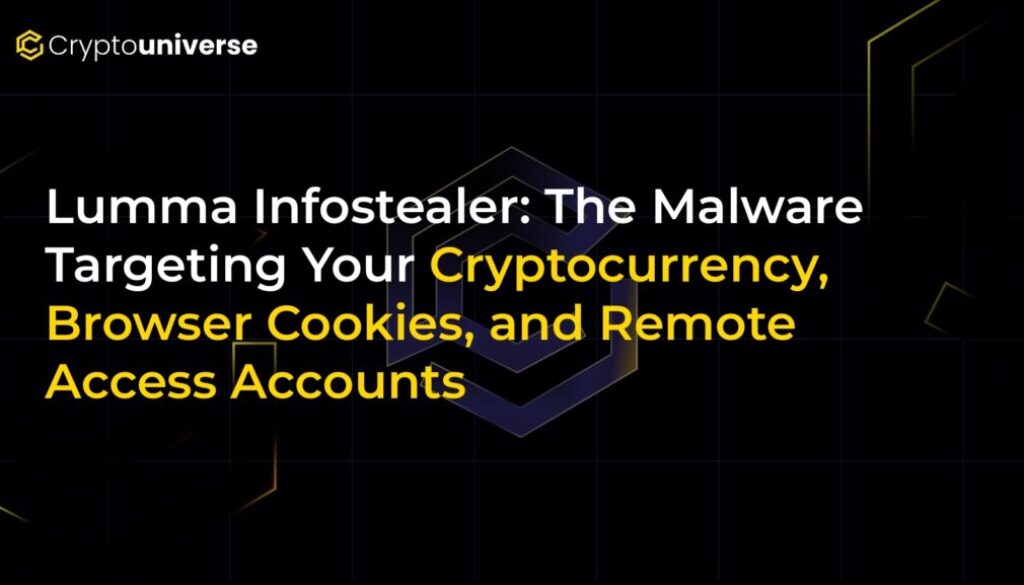Lumma Infostealer: The Malware Targeting Your Cryptocurrency, Browser Cookies, and Remote Access Accounts

A New Wave of Cyber Threats Targets Your Digital Wallet
In the ever-evolving landscape of digital security, a sophisticated and dangerous threat has resurfaced, aiming directly at the heart of your digital life: your cryptocurrency, personal data, and access credentials. Known as Lumma Infostealer, this malware is not just another virus; it’s a highly efficient data thief operating on a subscription model, making it accessible to a wide range of cybercriminals.
This potent malware specifically targets Windows users, systematically hunting for high-value information, with a particular focus on cryptocurrency wallets. If you store passwords in your browser or manage digital assets on your PC, you need to understand how Lumma works and how to protect yourself.
What is Lumma Infostealer and Why is it So Dangerous?
Lumma Infostealer operates under a Malware-as-a-Service (MaaS) model. Think of it like a software subscription, but for crime. This allows even attackers with limited technical skills to rent access to the malware, launch sophisticated campaigns, and steal sensitive data. This “democratization” of cybercrime means the threat is more widespread and unpredictable than ever.
The primary goal of Lumma is simple: to steal information. It’s designed to be a silent intruder, infiltrating your system and exfiltrating valuable data before you even know it’s there.
The Attack Chain: How Lumma Sneaks Onto Your System
Lumma’s creators have developed a multi-stage attack process designed to bypass traditional security measures like antivirus software. Here’s a step-by-step breakdown of how an infection typically occurs:
1. The Lure: Cracked Software and Deceptive Downloads
The attack often begins with a phishing campaign. You might come across a link for a “cracked” or pirated version of popular software. To appear legitimate, these malicious files are often hosted on trusted cloud platforms like MEGA, making them harder to flag as suspicious.
2. The Trojan Horse: A Fake Installer
When a victim downloads and runs the fake “setup.exe” file, they are unknowingly initiating the infection. The installer, often a Nullsoft Scriptable Install System (NSIS) package, appears legitimate but secretly extracts malicious files into the temporary system folder (%Temp%).
3. Evasion and Execution: Hiding in Plain Sight
To avoid detection, Lumma employs several clever tricks. It launches a decoy document, such as a fake “.docx” file, to distract the user. Behind the scenes, it uses a series of commands and an AutoIt-based script to reconstruct its core payload. Using advanced techniques like shellcode injection and process hollowing, it injects itself into a benign, running process on your computer, effectively wearing a disguise to hide from security software.
4. Data Exfiltration: Stealing the Crown Jewels
Once active and hidden, Lumma connects to a remote command-and-control (C2) server. From there, it begins systematically scanning the infected machine and stealing a wide range of valuable data, including:
- Cryptocurrency Wallet Information: This is its highest-priority target, seeking out wallet files and credentials to drain your digital assets.
- Browser Data: Stored passwords, credit card numbers, and session cookies are stolen, giving attackers access to your online accounts.
- Remote Access Credentials: Configuration files for VPNs and Remote Desktop Protocol (RDP) are targeted, which can lead to deeper network breaches.
- Telegram Data: Session information from the popular messaging app is also on its list.
This stolen data is sent back to the attackers, who can use it for identity theft, sell it on dark web forums, or launch further attacks against individuals and corporations.
Why Your Antivirus Might Not Be Enough
Lumma is designed for stealth. It actively checks for the presence of popular antivirus solutions like Sophos, Norton, ESET, Bitdefender, and Avast. If it detects any of them, it can deactivate its functions to avoid being caught. Its modular design and frequent updates mean that traditional, signature-based antivirus programs often fail to recognize it. This is why modern, behavior-based security solutions like Endpoint Detection and Response (EDR) are becoming essential for identifying such threats in real-time.
How to Protect Your Crypto and Digital Assets from Lumma
While the threat is sophisticated, you can take several concrete steps to fortify your defenses and protect your valuable assets.
- Avoid Pirated Software: The most common entry point for Lumma is through cracked software. Never download applications from untrusted sources. Always use official websites or reputable storefronts.
- Enable Multi-Factor Authentication (MFA): MFA is your best defense against credential theft. Even if an attacker steals your password, they won’t be able to access your crypto exchange or email account without the second factor.
- Use a Dedicated Password Manager: Avoid saving sensitive passwords directly in your web browser. A dedicated, encrypted password manager is a much safer alternative for storing credentials.
- Keep Your Systems Updated: Ensure your operating system and all software, especially your browser and security tools, are always up to date to patch potential vulnerabilities.
- Be Skeptical of Unsolicited Files: Exercise caution with any unexpected attachments or files, even if they appear to come from a known source.
The Bottom Line: Vigilance is Key
The rise of the Malware-as-a-Service economy, exemplified by threats like the


